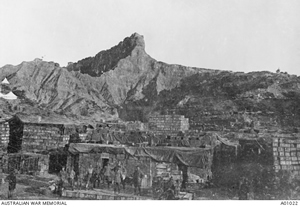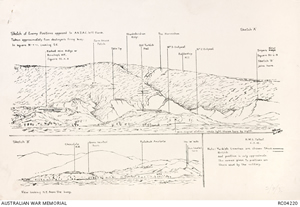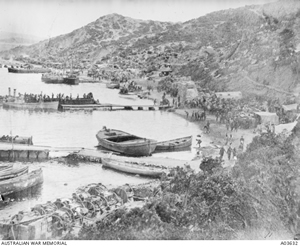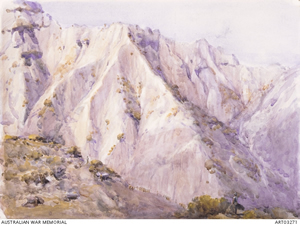Geography Stage 4
Overview
Students undertake a case study of the landscapes and landforms of five sites on the Gallipoli Peninsula. Drawing on their analysis of the aesthetic, cultural, spiritual and economic values of the Gallipoli landscape, they describe the value of Gallipoli for tourism. Students consider competing values and provide suggestions on how these can be managed. They create a detailed tourism blog post for potential visitors to the Gallipoli Peninsula.

Heights of Plugge's Plateau, Walker's Ridge and the Sphinx Gallipoli by Horace Moore-Jones, 1915–1916
©Public Domain (AWM ART031961)
Teaching and learning activities
Question: What is the value of the landscapes and landforms of the Gallipoli Peninsula for tourism?
What environmental and human processes form and transform landscapes and landforms?
Why do people value landscapes and landforms?

Boxed stores stacked at the Army Service Corps (ASC) depot, showing the Sphinx in the background.
©Public Domain (AWM A010222)

Gallipoli map: Sketches from HMS TALBOT July 1917, by Printing Section GHQ MEF
©Public Domain (AWM RC042203)

Stores, limbers and troops along the beach at Anzac Cove, Gallipoli, Turkey, 1915
©Public Domain (AWM A036324)

North side of the Sphinx at Gallipoli painted by Horace Moore-Jones, 1915
©Public Domain (AWM ART032715)
Engage
View the image of the troops along the beach of Anzac Cove and Major Hore’s drawing6s of the landscape and landforms recorded during the First World War.
Students describe the landscape and the challenges it presented to the Anzac troops in the First World War.
Define
Define the terms ‘landscape’, ‘landform’ and ‘geomorphic processes’. Use images from the Gallipoli Peninsula to illustrate each.
Resource: Landscapes and landforms (.pdf 278kB)7
Acquire and process geographical information
Students locate the Gallipoli Peninsula on a map of Turkey.
Students view a topographic map, 1917 sketch map and Google Earth satellite images of the Gallipoli Peninsula.
Using the online A Walk around 14 Battlefield Sites8, students undertake a ‘virtual field trip’ to five of the sites along the Anzac Walk on the Gallipoli Peninsula. They read about each site’s significance and locate current images of the sites; locate each site on a topographic map; create a table that answers the following questions, and create a photo sketch for one site.
-
What is there? —natural and human features including landscape, landforms, vegetation
-
Where is it? —locate on a map, describe location, explain accessibility
-
Why is it there? —geomorphic processes, land management, interconnections
-
Why care? —aesthetic, cultural, spiritual and economic values for people
The Gallipoli Peninsula Anzac Walk virtual field trip sites:
1. North Beach and The Sphinx9
3. Anzac Cove10
8. Lone Pine Plateau11
10. Quinn's Post12
12. The Nek13
Resources:
Video interviews with Wiley Park Girls High School students who visited Gallipoli (See the Concepts tab in Including all students in this resource.)
Gallipoli images, 2014 (opens in a new window)
Communicate geographical information
Tourism to Gallipoli has steadily increased over the past ten years with crowds reaching 10 000 for the Anzac Day services held there. But there are concerns:
‘Gallipoli grand final’ an ‘insult to Anzacs' memory’
As the number of tourists on the peninsula grows, an outspoken Australian historian has compared the atmosphere to a grand final footy match.
“I think this now is the Gallipoli grand final,” Jonathan King said.
“It's a juggernaut, a commercial juggernaut ... we've got cruise ships that have come all the way from Australia with rock stars singing on them with bands playing, we've got surf boat races, we've got all sorts of sporting events, cricket, we've got a gala ball, a black tie ball.
“This is an insult I reckon to the Anzacs' memory.”
Quotes by Jonathon King from Gallipoli 2015: Tour operator concerned VIPs given priority over Anzac Day tourists14 ABC News, 21 April 2015
Drawing on their analysis of the aesthetic, cultural, spiritual and economic values of the Gallipoli landscape, students describe the value of Gallipoli for tourism. They consider competing values and provide suggestions on how these can be managed. Students create a detailed and illustrated tourism blog post for potential day visitors to the Gallipoli Peninsula.
Learning concepts
These additional questions can be used for discussion or further investigations.
Challenge
What challenges are faced in managing tourism on the Gallipoli Peninsula? How have are these challenges being managed or dealt with?
Change
How did the landscape change after the landing of the Anzacs at Gallipoli? What features remained the same?
Caring
What evidence is there of care for the sites on the Gallipoli Peninsula? What evidence is there of the relationship between Turkey and Australia at the site?
Community
How does the Australian and Turkish communities value the Gallipoli Peninsula? How is this demonstrated?
Commemoration
What human features at the site commemorate the Turks and the Anzacs who lost their lives there?
Syllabus links
Landscapes and landforms
GE4-2 describes processes and influences that form and transform places and environments
GE4-4 examines perspectives of people and organisations on a range of geographical issues
GE4-7 acquires and processes geographical information by selecting and using geographical tools for inquiry
GE4-8 communicates geographical information using a variety of strategies
Landscapes and landforms
Students:
-
investigate different landscapes and the geomorphic processes that create distinctive landforms, for example: (ACHGK048, ACHGK050)
– identification of a variety of landscapes and landforms
– explanation of geomorphic processes that create landforms eg weathering, erosion, deposition, tectonic activity
– examination of ONE landscape and its distinctive landforms
Value of landscapes and landforms
Students:
-
investigate the aesthetic, cultural, spiritual and economic value of landscapes and landforms for people, including Aboriginal and Torres Strait Islander Peoples, for example: (ACHGK049)
– explanation of the aesthetic value of landscapes and landforms to culture and identity
– description of the cultural and spiritual value of landscapes or landforms in different places
– identification of how a landscape can have economic value for different people
Links
- https://www.awm.gov.au/collection/ART03196/
- https://www.awm.gov.au/collection/A01022/
- https://www.awm.gov.au/collection/RC04220/
- https://www.awm.gov.au/collection/A03632/
- https://www.awm.gov.au/collection/ART03271/
- http://www.gallipoli.gov.au/an-artist-at-gallipoli/hores-drawings.php
- http://www.geogspace.edu.au/verve/_resources/2.3.4.2_1_Landscapes_landforms_pdf.pdf
- http://www.gallipoli.gov.au/anzac-battlefield-sites-walk/anzac-walk-overview.php
- http://www.gallipoli.gov.au/anzac-battlefield-sites-walk/site-1-north-beach.php
- http://www.gallipoli.gov.au/anzac-battlefield-sites-walk/site-3-anzac-cove.php
- http://www.gallipoli.gov.au/anzac-battlefield-sites-walk/site-8-lone-pine-cemetery.php
- http://www.gallipoli.gov.au/anzac-battlefield-sites-walk/site-10-quinns-post.php
- http://www.gallipoli.gov.au/anzac-battlefield-sites-walk/site-12-the-nek-cemetery.php
- http://www.abc.net.au/news/2015-04-21/grumbling-on-gallipoli-peninsula-as-anzac-centenary-approaches/6407790